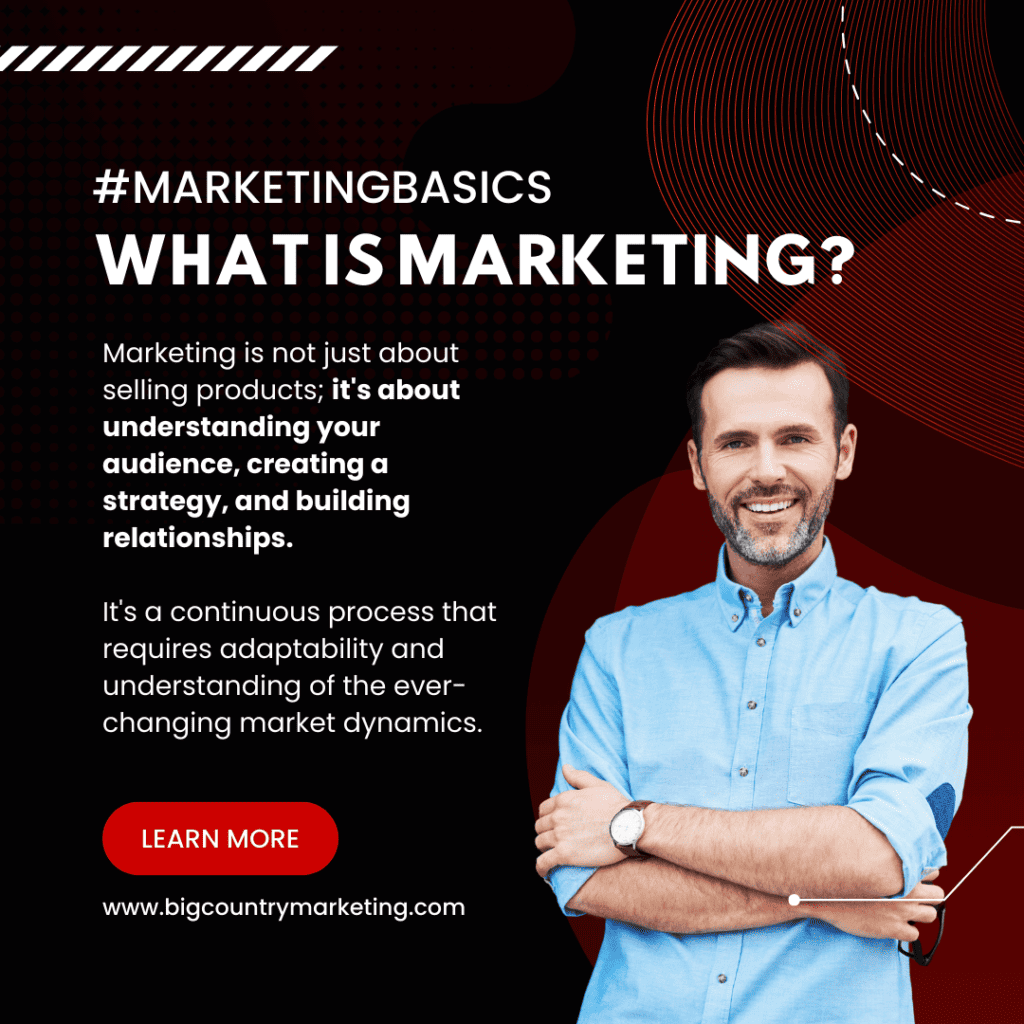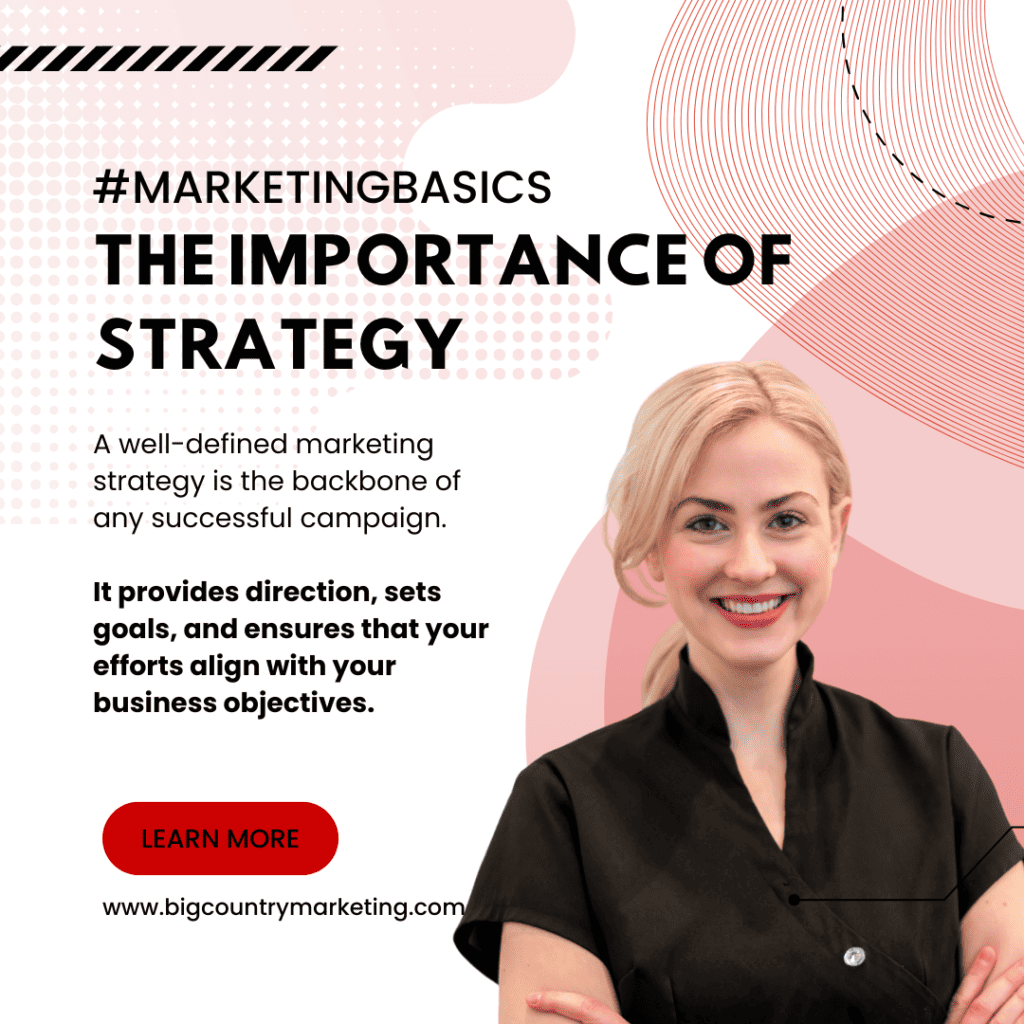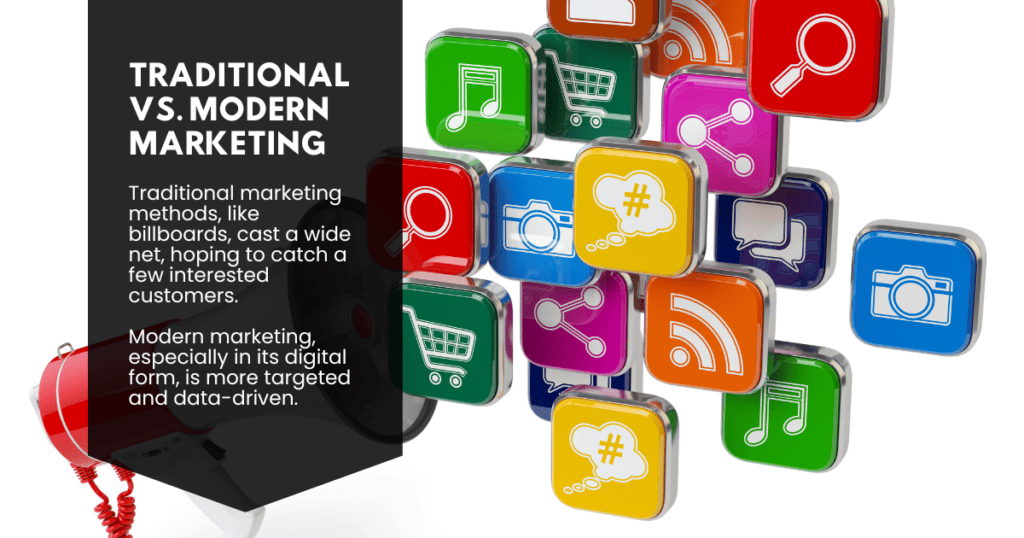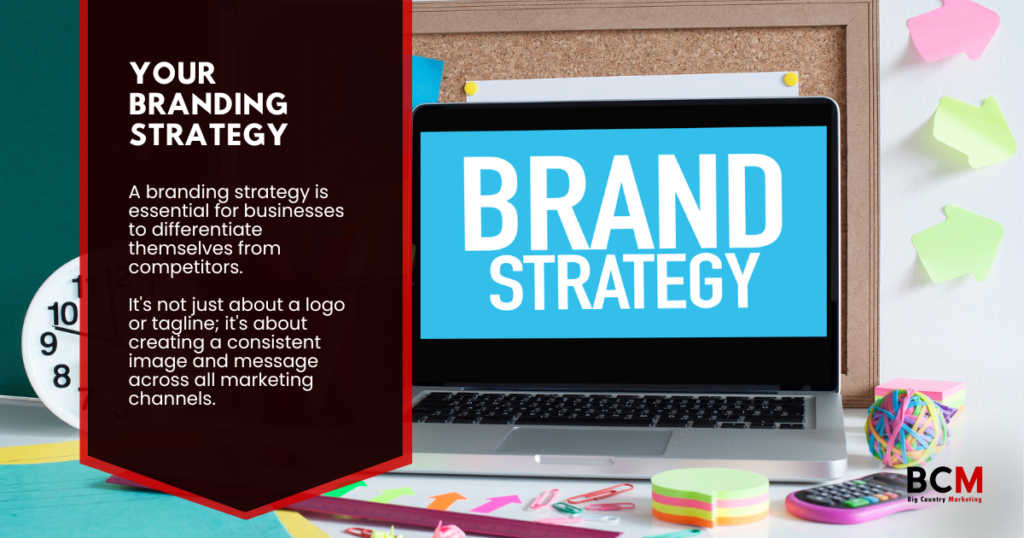Marketing Basics (and Strategy) for Small Business Owners: Navigating the Mind-Numbing Maze of Modern Marketing
Every busy business owner knows that time is of the essence. Yet, understanding the core of marketing basics and strategy is non-negotiable for success.
In a world overflowing with information, we’ve distilled the essence of what you truly need to know.
Dive deep into this guide, tailored for entrepreneurs and small business owners who wear multiple hats, and unlock the secrets to effective marketing that can propel your business forward.

Marketing is the process of communicating the value of a product or service to potential clients and customers. It aims to provide solutions to their problems or needs.
Do you sometimes feel swamped by the tidal wave of marketing advice out there?
Every corner of the internet seems to shout a new “revolutionary” tactic, making the world of marketing seem like an intricate maze.
And so, understandably, it’s easy to get caught up in the overwhelming nature of modern marketing, especially when everyone claims to have the “next big thing.”
But here’s a little secret: these flashy new tactics mean nothing, especially if you don’t have a firm grasp on the foundational principles of small business marketing.
By mastering the fundamental marketing basics and strategy, businesses equip themselves with the tools to traverse the multifaceted world of modern marketing, offering a clearer path to more impactful, more informed, and more successful campaigns.
Let’s get real for a moment. Marketing isn’t just about chasing the latest trends or jumping on every new platform that pops up. It’s about understanding the core basics that have stood the test of time.
Think of it as building a house. You wouldn’t start with the roof, would you? Similarly, diving headfirst into advanced marketing strategies without a solid foundation is a recipe for confusion and missed opportunities.
So, if you’ve ever felt like you’re playing a never-ending game of catch-up, or if the vast landscape of marketing strategies feels more like quicksand than solid ground, take a deep breath.
We’re about to embark on a journey to demystify the essentials of small business marketing. Let’s ensure you have a rock-solid base to build upon.
Ready to dive deep into the world of marketing basics and strategy and cut through the noise to focus on what truly matters? Let’s go!
The Importance of Marketing for Small Business Owners: Why it Matters
Marketing is the lifeblood of any business, big or small. It’s the tool that introduces a business to the world, tells its story, and convinces consumers to become loyal customers.

A strong foundation of marketing basics and strategy ensures that whatever tactics you employ will be more effective and aligned with your business goals.
Defining Marketing
At its most basic, marketing is about promoting a product or service. According to the American Marketing Association, marketing is “the activity, set of institutions, and processes for creating, communicating, delivering, and exchanging offerings that have value for customers, clients, partners, and society at large.”
For me, marketing is about solving problems. It’s about understanding what a customer needs and presenting a product or service as the solution.
In my experience, successful marketing hinges on understanding customer pain points and effectively communicating how your product or service addresses those issues.

The Core Purpose of Marketing
The primary objective then is to bridge the gap between a business and its potential customers.
Effective marketing delves deep into the psyche of the consumer, identifying their desires, preferences, and pain points. By doing so, it allows businesses to tailor their offerings in a way that resonates with their target audience.
It’s about understanding the needs of the market and crafting strategies to meet those needs effectively.
In essence, marketing serves as the voice of a business, communicating its value proposition to the audience.
Furthermore, it fosters a two-way relationship, enabling businesses to not only speak to their customers but also listen, adapt, and evolve based on feedback and changing market dynamics.
The Significance for Small Businesses
At its most basic, marketing is about promoting a product or service. According to the American Marketing Association, marketing is “the activity, set of institutions, and processes for creating, communicating, delivering, and exchanging offerings that have value for customers, clients, partners, and society at large.”
For me, marketing is about solving problems. It’s about understanding what a customer needs and presenting a product or service as the solution.
In my experience, successful marketing hinges on understanding customer pain points and effectively communicating how your product or service addresses those issues.

For small businesses, marketing is not just a luxury; it’s a necessity.
A study by Forbes revealed that businesses that prioritize marketing are 60% more likely to achieve higher growth compared to those that don’t.
This is because marketing helps small businesses:
- Reach their target audience. In a world saturated with products and services, marketing ensures that a business’s offerings reach those who would benefit most from them.
- Build brand recognition. Consistent marketing efforts help embed a brand in the minds of consumers, making it the go-to choice when they’re ready to make a purchase.
- Engage and retain customers. Through marketing, businesses can foster relationships with their customers, ensuring loyalty and repeat business.
Driving Growth and Brand Recognition
Marketing is also the engine that propels a business forward.
It not only attracts new customers but also nurtures existing ones, ensuring a steady flow of revenue.
Moreover, as a brand becomes more recognizable through consistent marketing efforts, it gains a competitive edge.
A recognized brand often equates to trust in the eyes of consumers, and trust is a currency that can drive significant growth.
For further reading, review these 11 marketing basics essential for every small business owner looking to gain a competitive edge in today’s market.
Marketing Today: What Do I Need to Know About Modern-Day Marketing for My Small Business?
The marketing landscape has undergone a seismic shift in the past few decades.
As technology has advanced and consumer behavior has evolved, the strategies that once worked wonders for businesses might now seem outdated or even counterproductive.
For small business owners, understanding these changes is crucial to remain competitive and relevant.

While traditional methods can build brand awareness, modern methods can drive more targeted engagement and conversions.
Traditional vs. Modern Marketing
Traditional marketing, often referred to as “outbound” marketing, primarily involves pushing messages to consumers. This includes methods like TV and radio ads, billboards, and direct mail.
The approach is broad and aims to reach a large audience, but it’s often impersonal and interrupts the consumer’s experience.
On the other hand, modern marketing, or “inbound” marketing, is about pulling consumers in. It’s characterized by strategies like content marketing, SEO, and social media, where businesses provide value to attract potential customers.
The focus is on building relationships and creating a two-way dialogue.
Problems with Traditional Marketing
One of the main issues with traditional marketing is its intrusiveness.
Consumers today are bombarded with advertisements, leading to ad fatigue. Many have turned to solutions like ad blockers to enhance their online experience.
Additionally, traditional marketing methods can be expensive, with costs that might be prohibitive for small businesses.
There’s also a lack of precise targeting, meaning a significant portion of the advertising budget might be spent reaching individuals who aren’t interested in the product or service.
Rise of Modern Marketing
Modern marketing recognizes the empowered consumer. With the internet at their fingertips, consumers today are well-informed and often seek out information before making a purchase.
They value authenticity, transparency, and brands that align with their values. This has given rise to strategies that prioritize customer experience and value provision.
Content marketing, for instance, offers valuable information to consumers, positioning the brand as a trusted expert. Social media allows for direct engagement, fostering a sense of community.
Moreover, digital marketing tools offer unparalleled data analytics, allowing businesses to understand their audience better and tailor their strategies accordingly.
What you can take away from this is this: while traditional marketing methods still have their place, it’s evident that modern marketing offers a more targeted, cost-effective, and engaging approach.
What you can take away from this is this: while traditional marketing methods still have their place, it’s evident that modern marketing offers a more targeted, cost-effective, and engaging approach.
Particularly, for you, as a small business owner looking to make a mark in today’s competitive landscape, embracing modern marketing strategies is not just beneficial—it’s essential.
For a bit of related reading, learn how to navigate small business marketing to significantly impact the success of your marketing efforts.
Developing a Marketing Strategy for Your Small Business: Where to Even Begin?

While tactics can change based on new tools or platforms, the strategy should remain consistent and rooted in those foundational marketing principles. Without a clear strategy, even the best tactics can fall flat. And so, it’s essential to ensure that all marketing actions align with a broader strategy to achieve business goals effectively.
So far, we’re off to a good start– you now just got a crash course on the most basic of marketing basics and strategy.
Now, let’s move on to what I feel is one of the most neglected aspects of any small business’s marketing efforts: the marketing plan.
In essence, when developing a marketing strategy for your small business, it’s not just about promoting your products or services. It’s about creating a holistic approach that encompasses every aspect of your business, ensuring that all parts work in harmony towards a common goal.
Laying the Groundwork: Steps to Create an Effective Marketing Plan
Starting with a robust marketing plan is the cornerstone of any successful marketing strategy.
Here are the foundational steps to guide you:
- Do some market research. Begin by understanding your target audience. Dive into their demographics, preferences, and buying behaviors. There are a lot of tools out there now, such as SparkToro, for example, that can offer valuable insights.
- Set clear objectives for your brand. Define what you want to achieve. Whether it’s increasing brand awareness, driving sales, or boosting website traffic, having clear goals will guide your efforts.
- Allocate a bit of a budget. Determine how much you’re willing to invest in your marketing endeavors. Remember, it’s not about spending more, but spending wisely.
- Choose the right channels. Based on your target audience, decide where you’ll promote your business. This could be social media, email marketing, SEO, or traditional advertising.
- Create value-packed, market-relevant content. Develop content that resonates with your audience. This could be blog posts, videos, infographics, or podcasts.
- Monitor and adjust accordingly. Regularly review your strategy’s performance. Tools like Google Analytics can help track your progress. Adjust your tactics based on what’s working and what’s not.
The Interplay: Marketing, Sales, and Business Development
Understanding the synergy between marketing, sales, and business development is crucial.
While each has its unique role, they’re interconnected in driving business growth.
Marketing generates awareness and attracts potential customers.
Sales focuses on converting these potential customers into paying ones.
Meanwhile, business development looks at long-term value, building partnerships, and expanding market reach.
Aligning these three functions can lead to increased efficiency and growth. Understanding the nuanced differences between sales, marketing, and business development is crucial for devising an effective marketing strategy.
Grasping the Basics: Foundational Marketing Principles
While trends come and go, certain principles of marketing remain unchanged. These are rooted in understanding human behavior, needs, and motivations.
- Sell benefits, not features. Customers are more interested in how a product or service can benefit them rather than its technical specifications.
- Emotions drive purchases. People often make buying decisions based on feelings, not just logic or need, so you must appeal to their emotions instead.
- The Rule of Seven. It’s a classic marketing principle that suggests a prospect needs to see or hear your marketing message at least seven times before they take action. For this reason, you must ensure your brand messaging is consistent across all channels; it helps in building trust, recognition, and, most importantly, action.
- Prompt action using urgency, scarcity, and exclusivity. Limited-time offers or highlighting product scarcity can drive immediate action from potential buyers. On that same note, highlighting the uniqueness or limited availability of a product can make it more desirable.
- Social influence and peer pressure: People often look to others when making decisions. Highlighting how many others have bought or benefited from a product can sway decisions. Testimonials, reviews, and case studies can significantly influence purchasing decisions by validating your product’s value.
- Storytelling engages. Narratives and stories resonate more with audiences than plain facts or figures, making your brand memorable.
- Educate to convert. By providing valuable information or educating potential customers, you position your business as an expert and build trust.
- Personalization enhances the experience. Tailored marketing messages based on individual preferences or past behaviors can significantly boost engagement and conversions.
- Foster loyalty with transparency and reciprocity. Being open about business practices, pricing, and values can lead to increased customer loyalty and trust. In addition, offering something of value (like free content or samples) can encourage customers to reciprocate, often through purchases or loyalty.
- Value over price. Competing solely on price is a race to the bottom; instead, focus on the unique value your product or service provides.
- Simplicity sells. In an age of information overload, clear and straightforward messaging can stand out and be more effective.
- Loss aversion. People tend to prefer avoiding losses over acquiring gains. Highlighting what they might lose (e.g., missing out on an offer) can be a powerful motivator.
- The Anchoring Effect. People often rely heavily on the first piece of information they receive (the “anchor”) when making decisions. Initial pricing or first impressions can set the stage for future interactions.
- Commitment and consistency. Once someone has made a small commitment, like signing up for a newsletter, they’re more likely to continue in that direction and make a purchase.
- The Contrast Principle. People perceive things differently depending on their context. For instance, a product may seem more affordable when placed next to a higher-priced item.
These are just a few of those time-tested, classic marketing principles. By focusing on these foundational principles, businesses can create effective marketing strategies regardless of the current trends or tools of the day.
Striking the Right Balance: Tactics vs. Strategy
While tactics are the actionable steps taken to achieve a specific goal, strategy is the broader plan that guides the use of these tactics.
Think of strategy as the roadmap and tactics as the turns you take along the way.
A successful marketing approach requires a delicate balance between the two. Relying solely on tactics without a clear strategy can lead to disjointed efforts, while a strategy without the right tactics can lack execution.
Remember: it’s the harmony between the two that drives real results.
Staying Grounded: Avoiding the Trap of Trends
In the ever-evolving world of marketing, new trends emerge almost daily. While it’s essential to stay updated, it’s equally crucial not to get swept away by every new wave.
Not all trends will be relevant to your business or your audience. Instead of jumping on every new bandwagon, evaluate each trend’s potential impact on your business and decide whether it aligns with your overall strategy.
Again, consistency and authenticity often outweigh the fleeting buzz of a passing trend.
Identifying Your Target Market: Understanding Your Customers
Now, let’s talk about knowing your customers on a deeper level.
identifying and understanding your target market is not just about demographics or buying behaviors. It’s about delving deep into their psyche, understanding their worldview, and crafting strategies that resonate on a personal level.

By tapping into these psychological triggers, businesses can craft more compelling marketing messages and campaigns that resonate deeply with their audience.
The Imperative of Knowing Your Audience
Understanding your target audience is the cornerstone of any successful marketing strategy.
Without a clear picture of who you’re trying to reach, your marketing efforts can become scattered, leading to wasted resources and missed opportunities.
According to Forbes, truly understanding your audience can lead to more personalized marketing, better customer relationships, and increased sales.
Harnessing Tools and Techniques
Several tools and techniques can aid businesses in identifying and segmenting their target market:
- Surveys and Questionnaires: Direct feedback from potential or existing customers can provide invaluable insights into their preferences and behaviors.
- Market Research Firms: Companies like Nielsen or Ipsos specialize in gathering and analyzing data about various market segments.
- Social Media Analytics: Platforms like Facebook and Twitter offer insights into the demographics and behaviors of your followers.
- Customer Personas: Creating detailed profiles of your ideal customers can help in tailoring marketing strategies to specific segments.
Seeing Through the Customer’s Eyes
Adopting the customer’s perspective allows businesses to tailor their offerings and communications to resonate more deeply.
This involves understanding their pain points, desires, challenges, and aspirations.
By walking in their shoes, businesses can craft messages that speak directly to the heart of their audience.
Diving Deep into Human Psychology
The role of human psychology in marketing cannot be overstated. Emotions, biases, and cognitive processes play a significant role in purchasing decisions.
For instance, the principle of ‘reciprocity’ in psychology suggests that people feel an inherent need to give back when they receive something.
This can be leveraged in marketing through tactics like offering free samples or valuable content.
According to Psychology Today, understanding these psychological triggers can significantly enhance marketing effectiveness.
Branding is a unique psychological trick that creates a lasting impression in the minds of all of its customers. But not all purchases rely on branding. And there is actually a larger psychological factor in determining whether a person will be a lifelong customer of a business or not.
Creating an Effective Brand Identity: Stand Out from the Competition
When creating a brand identity for your business, you must go beyond simple aesthetics; it’s about encapsulating the essence of your business, standing out in the market, and resonating deeply with your target audience.

Without a strong branding strategy, businesses risk blending in with the competition and not effectively communicating their unique value proposition to potential customers. A weak or inconsistent brand can lead to confusion among consumers and missed opportunities in the market.
The Power of Branding in Marketing
Branding isn’t just about a catchy logo or a memorable slogan; it’s the essence of your business’s identity.
A strong brand serves as a promise to your customers, signaling the quality and reliability of your products or services.
A truly well-defined brand can drive customer loyalty, command premium prices, and even act as a protective barrier against competition.
Crafting a Memorable Brand Identity
To establish a brand that resonates and endures, consider the following steps:
- Define your brand’s core values. Understand what your business stands for. Is it innovation, customer service, or sustainability, perhaps? These values will guide all branding efforts.
- Develop a unique visual identity. This includes a distinctive logo, color scheme, and typography that aligns with your brand’s personality.
- Craft a consistent brand voice. Whether it’s professional, casual, or playful, ensure that your brand’s voice is consistent across all communication channels.
The Essence of Specialization
In a crowded marketplace, specialization can be a game-changer.
By focusing on a niche or specific segment, businesses can cater to the unique needs of a particular audience.
For instance, a brand specializing in organic skincare products immediately distinguishes itself from generic skincare brands.
Specialization not only helps in targeting marketing efforts more effectively but also in building a loyal customer base.
Differentiating from the Crowd
Differentiation is the art of setting your brand apart from competitors.
It’s about highlighting what makes your offerings unique and why customers should choose you over others.
Whether it’s through innovative products, exceptional customer service, or sustainable practices, differentiation is crucial.
As noted by Entrepreneur, brands that fail to differentiate risk getting lost in the sea of sameness, making it harder to attract and retain customers.
Building an Online Presence: Leveraging Digital Marketing Channels
In today’s interconnected world, having a robust online presence is more than just a luxury—it’s a necessity.
With consumers increasingly turning to the internet for information, shopping, and entertainment, businesses that fail to establish a digital footprint risk being left behind.
Building a robust online presence for your small business requires a multi-faceted approach, leveraging various digital channels to reach, engage, and convert your target audience.
Let’s have a look at four important digital marketing channels: your business website, your content marketing initiatives, your social media strategies, and email marketing.

In today’s digital-first world, mastering digital marketing channels, such as business websites, social media, SEO and content marketing, and email marketing, is crucial for businesses to reach their audience and achieve their growth goals.
Maximizing Your Website’s Potential: Optimizing for Search Engines
According to Search Engine Journal, 93% of online experiences begin with a search engine, underscoring the importance of SEO in driving organic traffic.
Search engine optimization (SEO) ensures that your website ranks higher on search engines, making it easier for customers to find you.
A well-optimized website is more than just a digital storefront; it’s a powerful tool that can drive traffic, generate leads, and convert visitors into loyal customers.
1. Website Design
Aesthetics matter. Your website’s design should reflect your brand’s identity and values. It’s not just about looking good; it’s about creating an environment where visitors feel comfortable and are encouraged to take action, whether that’s making a purchase or signing up for a newsletter.
2. User Experience (UX)
At the heart of a successful website is a seamless user experience (UX). A good UX design can significantly improve conversion rates and customer loyalty
UX encompasses the overall feel a visitor gets when navigating your site. It’s about ensuring that information is easily accessible, pages load quickly, and users can find what they’re looking for without hassle.
3. On-Page SEO
On-page SEO refers to the optimization of individual web pages to rank higher and earn more relevant traffic in search engines. It encompasses both the content and the HTML source code of a page.
Key elements include optimizing title tags, meta descriptions, header tags, and ensuring keyword-rich content.
Properly optimized pages are essential for search engine crawlers to understand the context and relevance of your content. On-page SEO, combined with high-quality content, can significantly improve a website’s search visibility and overall user experience.
Incorporating on-page SEO ensures that search engines can easily index your content, understand its context, and rank it appropriately. It’s a foundational aspect of website optimization that works hand-in-hand with other SEO practices to boost your site’s visibility.
4. Technical SEO
Beyond on-page content, the technical aspects of your website play a crucial role in its visibility on search engines.
This includes optimizing site speed, ensuring mobile-friendliness, creating an XML sitemap, and implementing structured data.
Search Engine Land emphasizes the importance of technical SEO as the foundation of any successful SEO strategy.
5. Local SEO
For businesses that operate in specific geographic areas, local SEO is essential.
This involves optimizing your website for local search terms, claiming and updating your business listings, and gathering positive reviews.
According to HubSpot, 46% of all Google searches are seeking local information, highlighting the importance of local SEO
6. Ecommerce Websites
If you’re selling products online, your website needs additional optimization. This includes creating clear product descriptions, implementing secure payment gateways, and optimizing product images.
BigCommerce notes that an optimized e-commerce site not only drives organic traffic but also reduces the cost of customer acquisition.
We’ve covered quite a bit on just your business website, but to sum it all up, optimizing your website is a multifaceted endeavor.
By focusing on user experience, design, and SEO best practices, small businesses can create a site that not only looks great but performs exceptionally in search rankings.
Content Marketing: Creating Valuable and Relevant Content for Your Customers
Content marketing is all about providing valuable information to your audience and establishing your brand as an authority in your field.
As the fuel that powers profitable digital marketing engines (yes, even for small businesses!), the ultimate goal of content marketing is to drive profitable customer action.
The Role of Content in Digital Marketing
Whether it’s a blog post that ranks on the first page of Google, a viral video on social media, or an email newsletter that keeps your brand top-of-mind, content plays a pivotal role.
Quality content can drive traffic, increase engagement, and boost conversions.
It helps businesses build trust with their audience, position themselves as industry experts, and nurture leads through the sales funnel.
According to the Content Marketing Institute, content marketing generates over three times as many leads as outbound marketing and costs 62% less.
Types of Content a Small Business Might Create
- Blog posts. Informative articles that address industry trends, answer common questions, or provide how-to guides.
- Videos. From tutorials to testimonials, videos can engage users and convey information quickly.
- Infographics. Visual representations of data or information, perfect for breaking down complex topics.
- Podcasts. Audio content that dives deep into industry topics or interviews with experts.
- Ebooks and whitepapers. In-depth guides or reports on specific topics, often used as lead magnets.
- Case studies. Detailed analyses showcasing the success of a product or service.
- Email newsletters. Regular updates sent to subscribers, offering insights, news, or promotions.
Best Practices and Strategies in Creating Engaging and Valuable Content
- Know Your Audience: Tailor your content to address the specific needs, questions, and pain points of your target audience.
- Maintain Consistency: Regularly publish content to keep your audience engaged and to establish authority in your niche.
- Prioritize Quality Over Quantity: It’s better to produce one high-quality piece of content than several mediocre ones.
- Optimize for SEO: Ensure your content is discoverable by integrating relevant keywords, optimizing meta tags, and building internal links.
- Promote Your Content: Use social media, email marketing, and other channels to amplify your content’s reach.
- Measure and Adjust: Use analytics tools to track the performance of your content and adjust your strategy based on the data.
In the digital age, content is king. By understanding its role, exploring various content types, and following best practices, small businesses can harness the power of content marketing to grow and thrive.
The Power of Social Media Marketing: Engaging with Your Audience
Social media platforms, from Facebook to Instagram to LinkedIn, offer businesses unparalleled opportunities to interact with their audience.
Beyond just promotions, these platforms allow for real-time engagement, feedback collection, and community building.
As highlighted by Sprout Social, 89% of consumers will buy from a brand they follow on social media, emphasizing the channel’s potential.
Importance of Social Media in Marketing
Social media has revolutionized the way businesses communicate with their customers. It provides a platform for brands to showcase their personality, share their stories, and engage in meaningful conversations.
According to HubSpot, 71% of consumers who have had a positive experience with a brand on social media are likely to recommend it to their friends and family. This word-of-mouth marketing can significantly boost brand credibility and drive organic growth.
Most Popular Social Media Platforms for Promoting Your Business
Each of these platforms offers unique features and caters to specific audience demographics.
- Facebook: A versatile platform suitable for businesses of all sizes, offering targeted advertising and community-building features.
- YouTube: The world’s largest video-sharing platform, ideal for tutorials, product reviews, and brand storytelling.
- Instagram: A visual-centric platform ideal for brands with strong imagery, from fashion to food.
- Twitter (X): A real-time platform perfect for news, updates, and customer service interactions.
- TikTok: A rapidly growing platform centered around short, engaging videos, popular with younger audiences.
- LinkedIn: The premier platform for B2B marketing, professional networking, and showcasing company culture and thought leadership.
- Pinterest: A discovery platform where users find inspiration, making it great for lifestyle, decor, and DIY brands.
- Reddit: Known as “the front page of the internet,” Reddit is a platform where users share content and engage in discussions. It’s essential for brands to approach Reddit authentically, participating in relevant communities or “subreddits.”
- Google Business Center (Google My Business): A crucial tool for local businesses, allowing them to manage their online presence across Google, including Search and Maps.
Remember: you don’t have to be in all of these channels. It’s crucial for businesses to identify which channels align best with their target audience and marketing objectives.
Just pick two or three and spend time mastering the nuances of those social media channels.
Community-Building on Social Media
In the realm of social media, having a large follower count is just the tip of the iceberg. Some might even argue that your follower count is merely a vanity metric.
The real power lies in cultivating a community of engaged and loyal followers who not only consume your content but also do business with you and advocate for your brand.
Here’s how to effectively build a community on social media:
- Foster genuine engagement. It’s not enough to just post content; you need to interact with your audience. Respond to comments, answer questions, and engage in discussions. This two-way communication makes followers feel valued and heard.
- Host interactive sessions. Platforms like Instagram and Facebook allow for live sessions. Use this feature to host Q&A sessions, product launches, or behind-the-scenes looks. It’s a direct way to engage with your audience in real time.
- Encourage user-generated content. Motivate your followers to create content related to your brand, whether it’s a product review, a testimonial, or a creative use of your product. Share these on your profile to show appreciation and build trust.
- Create exclusive groups. Platforms like Facebook allow you to create private groups. Use this to build an exclusive community for your most loyal customers, offering them special deals, previews, or simply a space to discuss and share.
- Celebrate milestones. Whether it’s your business’s anniversary, hitting a follower count, or celebrating a local event, involve your community in the celebration. It fosters a sense of belonging.
- Share stories. Not just the feature on Instagram and Facebook, but real stories—success stories of customers, employee spotlights, or your business journey. It humanizes your brand and makes it relatable.
- Seek feedback. Use your community as a sounding board for new ideas, products, or content. It not only provides valuable insights but also makes the community feel involved in your brand’s decisions.
Building a community on social media is a continuous effort. It’s about showing up consistently, being genuine, and placing your audience at the heart of your strategy.
When done right, it transforms casual followers into brand ambassadors, amplifying your reach and influence.
Best Practices and Strategies in Optimizing Your Social Media Posts and Presence
- Ensure consistent branding. Ensure your profile pictures, bios, and posts align with your brand’s voice and aesthetics.
- Engage regularly. Respond to comments, participate in discussions, and acknowledge feedback.
- Employ analytics. Monitor post performance to understand what resonates with your audience and adjust your strategy accordingly.
- Leverage user-generated content (UGC). Encourage customers to share their experiences and feature their content on your profiles.
- Schedule your posts in advance. Use tools to plan and automate your posts, ensuring consistent engagement without constant manual effort.
- Stay updated. Social media platforms frequently update their algorithms and features. Stay informed to maximize your reach and engagement.
Harnessing the power of social media marketing requires a strategic approach, genuine engagement, and a commitment to delivering value. When done right, it can elevate your brand, foster loyalty, and drive tangible business results.
Utilizing Email Marketing: Nurturing Relationships and Driving Sales
Despite the rise of new communication platforms, email remains a potent tool for businesses.
Email marketing offers a direct line of communication to your audience, unfiltered by algorithms.It’s personal, direct, and offers one of the highest ROI among digital marketing channels.
Case in point: HubSpot notes that for every $1 spent on email marketing, businesses can expect an average return of $42.
Through newsletters, promotions, and personalized campaigns, email marketing can nurture leads and drive repeat sales.
From Lead Generation to Lead Nurturing
While generating new leads is crucial, nurturing existing leads often holds the key to conversion.
It’s about building a relationship over time, understanding the needs of your potential customers, and offering them value consistently.
Email marketing allows for personalized communication, making it easier to cater to the specific interests and pain points of each lead, guiding them down the sales funnel.
The Resurgence of Newsletters
Newsletters are making a comeback, and for a good reason. They offer brands a platform to share insights, stories, and updates in a consolidated format.
More than just promotional tools, well-crafted newsletters can establish your brand as a thought leader in the industry, fostering trust and loyalty among subscribers.
Platforms like Substack and Revue have further popularized the newsletter format, allowing creators and businesses alike to monetize their content directly.
Best Practices in Email Marketing
Incorporating these best practices and understanding the evolving landscape of email marketing can help brands maintain a strong, meaningful connection with their audience, driving both engagement and sales.
- Segmentation: Not all subscribers are the same. Segment your email list based on behavior, interests, or demographics to send tailored content that resonates.
- Personalization: Use data to personalize your emails, addressing the recipient by name or referencing their past interactions with your brand.
- Mobile Optimization: With a significant chunk of emails being opened on mobile devices, ensure your emails are mobile-friendly.
- Engaging Content: Prioritize quality over quantity. It’s better to send fewer emails that offer real value than to bombard subscribers with constant promotions.
- Clear Call-to-Action: Every email should have a clear purpose, whether it’s reading a blog post, checking out a sale, or providing feedback.
- Test and Analyze: Use A/B testing to determine what subject lines, content formats, or sending times work best. Regularly analyze open rates, click-through rates, and conversion rates to refine your strategy.
Even in an age dominated by social media and instant messaging, email remains a cornerstone of digital marketing. Make sure you include email marketing in your small business marketing efforts.
Other Digital Marketing Channels
In the vast landscape of digital marketing, while some channels dominate the spotlight, others offer unique opportunities often overlooked.
Delving into these lesser-discussed avenues can unveil fresh strategies to engage audiences and drive results.
- Advertising. Beyond organic reach, paid advertising plays a pivotal role in digital marketing. Platforms like Google Ads, Facebook Ads, and programmatic advertising networks allow businesses to target specific demographics, ensuring that their message reaches the right audience. With options ranging from display ads to video ads, businesses can choose the format that best aligns with their goals and audience preferences.
- Chatbots. In an era where instant communication is prized, chatbots offer businesses a way to engage with customers in real time. Integrated on websites or platforms like Facebook Messenger, chatbots can answer queries, assist with purchases, or even gather feedback, enhancing user experience and freeing up human resources.
- Funnel Marketing. Funnel marketing is a systematic approach to guiding potential customers through a series of stages, from initial awareness to final conversion. It’s about crafting tailored content and interactions for each step, ensuring that prospects are nurtured and engaged at every touchpoint. Whether it’s capturing initial interest with a compelling lead magnet or sealing the deal with a targeted sales pitch, funnel marketing optimizes the customer journey, turning casual browsers into loyal customers.
- Mobile Marketing. With the majority of internet users accessing the web via mobile devices, mobile marketing is no longer optional. This encompasses everything from mobile-optimized websites and ads to SMS marketing campaigns. Apps, push notifications, and location-based offers are other tools that businesses can leverage to engage their mobile audience.
- Digital PR. Digital PR involves building a brand’s presence online through storytelling and building relationships with online journalists and influencers. It’s about creating buzz-worthy content, earning backlinks, and improving online reputation. Whether it’s getting a mention in a popular online publication or collaborating with a well-known influencer, digital PR can significantly boost a brand’s visibility and credibility.
Exploring these channels and integrating them into a cohesive digital marketing strategy can help businesses tap into new audiences and further their reach in the digital landscape.
Other Small Business Marketing Strategies

Relying solely on digital or traditional methods can limit a business’s reach. An integrated strategy ensures a broader and more effective reach, capturing a wider audience and maximizing return on investment.
While digital marketing channels have taken the forefront in recent years, there are several other strategies that small businesses can leverage to enhance their reach and engagement.
These methods often focus on building genuine relationships and tapping into existing communities and networks.
Direct Mail
Direct mail is a traditional marketing strategy that involves sending physical promotional materials directly to potential customers’ mailboxes.
It’s about creating tangible, personalized touchpoints that stand out amidst the digital noise.
Whether it’s a beautifully designed postcard, a special offer coupon, or an informative newsletter, direct mail offers a tactile experience that can leave a lasting impression, driving engagement and fostering brand loyalty in a uniquely personal way.
Influencer Marketing
Influencer marketing involves partnering with individuals who have a significant following or influence in a particular niche.
By collaborating with these influencers, businesses can tap into their audience, gaining exposure and credibility. It’s especially effective for brands targeting younger demographics who heavily rely on influencers for purchase decisions.
The key is to choose influencers whose values align with the brand and who genuinely resonate with the product or service.
Strategic Partnerships
Forming strategic partnerships can be a game-changer for small businesses.
By collaborating with complementary businesses, both parties can benefit from shared resources, audiences, and expertise. For instance, a local coffee shop might partner with a nearby bookstore for joint promotions.
Such partnerships can lead to increased exposure without the hefty advertising costs.
Event Marketing
Hosting or participating in events can significantly boost a brand’s visibility and engagement.
Whether it’s a product launch, workshop, or community event, these gatherings offer a chance for businesses to interact directly with their audience.
Events provide an opportunity for potential customers to experience the brand firsthand, ask questions, and build a personal connection.
In the age of digital interactions, the tangible experiences offered by events can set a brand apart.
In-Store Marketing
In-store marketing refers to the tactics and strategies employed within a physical retail environment to attract, engage, and convert shoppers.
It’s about enhancing the shopping experience, guiding purchase decisions, and reinforcing brand values.
Whether it’s through eye-catching product displays, interactive kiosks, or exclusive in-store promotions, in-store marketing aims to create memorable moments that not only drive sales but also build a deeper connection between the brand and its customers.
Local Marketing or Community Marketing
For small businesses, the local community is often their primary audience. Tapping into this community through local marketing strategies can yield significant dividends.
This could involve sponsoring local sports teams, participating in community fairs, or even hosting workshops.
Community marketing focuses on fostering a sense of belonging and building long-term relationships rather than immediate sales. It’s about being an integral part of the community fabric and being the go-to business in the locality.
Guerrilla Marketing
Guerrilla marketing is an unconventional strategy that relies on surprise, creativity, and often low-cost tactics to make a significant impact and leave a lasting impression on consumers.
It’s about thinking outside the box, breaking the norms, and leveraging elements of surprise to capture attention.
Whether it’s a flash mob in a public square, a mysterious mural appearing overnight, or a unique pop-up event, guerrilla marketing seeks to create buzz and virality, turning everyday scenarios into memorable brand experiences.
So, as you can see, while the digital realm offers a plethora of marketing opportunities, these traditional strategies still hold immense value.
They emphasize genuine relationships, community involvement, and personal touchpoints, which can be incredibly impactful for small businesses looking to make a lasting impression.
Measuring Success: Tracking and Analyzing Your Marketing Efforts

Without proper measurement and analysis, businesses might continue to invest in ineffective strategies, leading to wasted resources and missed opportunities. Regular analysis ensures that strategies are refined and optimized for better results.
In the realm of marketing, it’s not enough to simply implement strategies and hope for the best.
To truly understand the impact of your efforts and optimize for future campaigns, it’s crucial to measure and analyze results.
This ensures that your marketing budget is being spent wisely and that your strategies are effectively driving business growth.
The Imperative of Clear Objectives and KPIs
Before diving into any marketing campaign, it’s essential to set clear objectives.
What do you hope to achieve? Whether it’s increasing website traffic, boosting sales, or enhancing brand awareness, having a clear goal will guide your efforts.
Once objectives are set, Key Performance Indicators (KPIs) come into play. KPIs are measurable values that demonstrate how effectively a company is achieving its business objectives.
For instance, if your goal is to enhance brand awareness, a potential KPI might be the number of shares your content receives on social media.
By setting clear KPIs, businesses can ensure they’re on the right track to achieving their marketing objectives.
Harnessing Tools and Techniques for Marketing Analytics
Today, there’s no shortage of tools available to help businesses track and analyze their marketing efforts. Here are some of the most effective:
- Google Analytics: This free tool allows businesses to monitor their website traffic, understand user behavior, and see which channels are driving the most conversions. It’s a staple for any business with an online presence. Source
- Social Media Insights: Platforms like Facebook, Instagram, and Twitter offer built-in analytics tools. These provide insights into post engagement, audience demographics, and optimal posting times.
- Email Marketing Analytics: Tools like Mailchimp and HubSpot provide detailed reports on email open rates, click-through rates, and conversion rates, helping businesses understand the effectiveness of their email campaigns. Source
- CRM Systems: Customer Relationship Management (CRM) systems like Salesforce and Zoho offer analytics features that can track sales, customer interactions, and the effectiveness of marketing campaigns.
- A/B Testing Tools: Platforms like Optimizely allow businesses to test different versions of their content to see which performs best, optimizing for conversions and engagement. Source
Remember, tracking and analyzing marketing efforts is not just a nice-to-have—it’s essential.
By setting clear objectives, monitoring KPIs, and leveraging the power of analytics tools, businesses can ensure their marketing strategies are effective, optimize for future campaigns, and drive tangible business growth.
Budgeting for Marketing: Allocating Resources Wisely

Without a clear budget, businesses risk overspending on marketing or not allocating enough resources to critical areas, potentially hindering growth. Proper budgeting ensures efficient use of resources and aligns marketing efforts with business objectives.
Crafting a marketing strategy is only half the battle; ensuring you have the budget to execute it is equally crucial.
Allocating resources wisely is not just about how much you spend, but where and when you spend it. A well-planned marketing budget can be the difference between a successful campaign and a wasted investment.
Tips for Effective Marketing Budget Allocation
Here’s how to ensure every dollar on your marketing budget is put to its best use.
- Align with business goals. Before setting a budget, understand your business’s primary objectives. Are you looking to increase brand awareness, drive sales, or enter a new market? Your budget should reflect these goals. Source
- Prioritize high-performing channels. Analyze past campaigns to determine which channels yielded the best results. Allocate more funds to these high-performing channels while reconsidering or optimizing lower-performing ones.
- Stay flexible. The digital marketing landscape is ever-evolving. It’s essential to maintain some flexibility in your budget to capitalize on new opportunities or adjust strategies as needed.
- Factor in hidden costs. Beyond ad spend and campaign costs, consider other expenses like tools, software, and third-party services. Source
- Regularly review and adjust. A marketing budget isn’t set in stone. Regularly review your spending and adjust as necessary to ensure you’re getting the most bang for your buck.
ROI Considerations for Marketing Investments
Investing in marketing is essential, but understanding the return on those investments is paramount. Dive into the metrics and methods to accurately gauge the effectiveness of your marketing spend.
- Understand the metrics. ROI isn’t just about revenue. Consider other metrics like customer lifetime value, customer acquisition cost, and brand equity when assessing the return on your marketing investments. Source
- Test and measure. Before rolling out a large campaign, test it on a smaller scale to gauge its potential ROI. This can help you avoid significant investments in low-return initiatives.
- Consider long-term impact. Some marketing efforts, like brand awareness campaigns, might not yield immediate returns but can be valuable in the long run. It’s essential to consider both short-term and long-term ROI.
- Leverage analytics tools. Tools like Google Analytics and CRM systems can provide insights into how your marketing efforts are translating into sales and conversions, helping you understand your actual ROI.
Keep in mind that a well-thought-out marketing budget is more than just numbers on a spreadsheet. It’s a strategic tool that, when used effectively, can drive significant growth for your business.
By allocating resources wisely and keeping a keen eye on ROI, businesses can ensure that every dollar spent on marketing brings maximum value.
Staying Ahead of the Competition: Monitoring and Adapting Your Marketing Strategy

Businesses that don’t continue to evolve their marketing knowledge risk falling behind and not leveraging the latest strategies and tools available. Staying updated ensures that businesses are always at the forefront of marketing innovations.
In the ever-evolving landscape of digital marketing, staying static is not an option.
To remain competitive, businesses must be proactive, continuously updating their strategies to reflect the latest trends and best practices.
This not only ensures that they stay ahead of their competitors but also that they meet the changing needs and preferences of their target audience.
The Importance of Continuous Learning in the Digital Marketing Space
The digital world is in a constant state of flux, with new platforms, technologies, and consumer behaviors emerging regularly.
For businesses, this means that the strategies that worked yesterday might not be as effective today.
Continuous learning and adaptation are crucial for any marketer looking to stay relevant in this dynamic environment.

Tips to Stay Updated with the Latest Marketing Trends and Strategies
Staying updated in the digital marketing realm is not just about being aware; it’s about being proactive. Here are some actionable tips to ensure you’re always at the forefront:
- Subscribe to Industry Newsletters: Websites like Marketing Land and Adweek offer daily insights into the latest marketing news and trends.
- Attend Webinars and Conferences: Events such as INBOUND by HubSpot or the Social Media Marketing World Conference provide valuable insights from industry leaders.
- Engage in Online Communities: Platforms like Reddit’s r/marketing or GrowthHackers allow marketers to discuss the latest trends, share experiences, and seek advice.
- Invest in Training and Courses: Continuous learning platforms like Coursera or Udemy offer courses on the latest digital marketing techniques and tools.
- Test and Experiment: The best way to understand a new trend or strategy is to implement it. Regularly testing new approaches and analyzing their outcomes can provide firsthand insights into what works and what doesn’t.
The key to staying ahead in the competitive world of small business marketing is a commitment to continuous learning and adaptation.
By staying updated with the latest trends and strategies, businesses can ensure that their marketing efforts remain effective and that they continue to achieve their objectives.
Conclusion: A Final Word on Marketing Basics and Strategy

Waiting for the “perfect” marketing strategy can lead to missed opportunities and stagnation. It’s crucial to dive in, start with what you know, learn from real-world experiences, and adjust your strategies as you go. Every step taken is a lesson learned, propelling your business forward.
Having delved deep into the intricacies of marketing basics and strategy, you’re now equipped with a wealth of knowledge to elevate your small business marketing efforts. But as with any journey, acquiring knowledge is just the beginning. The real magic happens when you put that knowledge into action.
Remember, the world of marketing is dynamic and ever-evolving. While the foundational principles remain consistent, the tactics and strategies will continue to adapt to the changing digital landscape. It’s essential to approach marketing with a curious mindset, always ready to learn and adapt. Don’t be afraid to experiment with new strategies, but also ensure you’re grounded in the tried-and-true principles that have stood the test of time.
As you move forward, ponder this: Marketing is not just about selling a product or service; it’s about telling a story, building relationships, and creating value. Your brand’s story is unique, and it’s up to you to tell it in a way that resonates with your audience.
For even more insights, strategies, and tips on small business marketing, don’t stop here. Dive deeper into our extensive collection of articles right here on our website. Your journey to mastering the art of marketing has only just begun.
So, check out more small business marketing articles and continue your learning journey with us!






